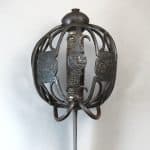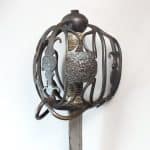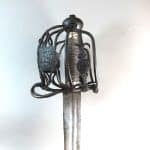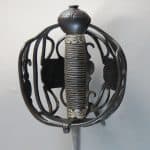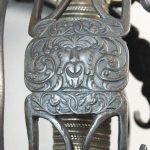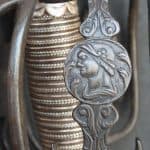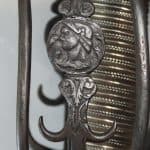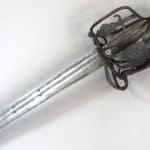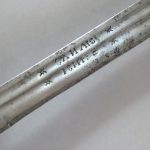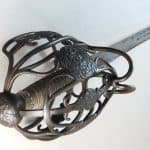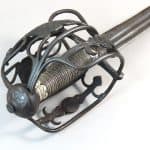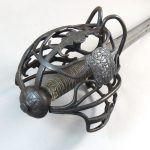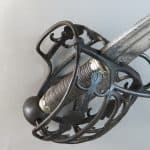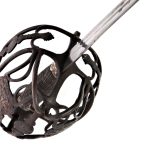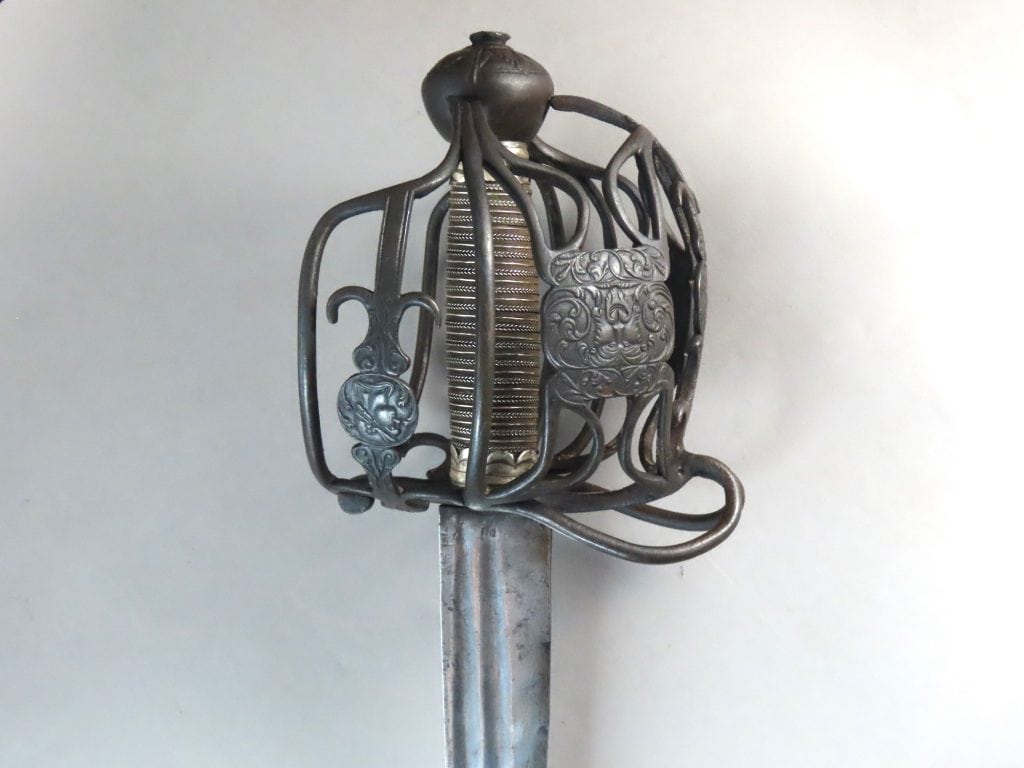
A Fine and Rare English Basket Hilted Sword Circa 1660 to 1685
To enquire about this itemplease click here
Price: £7,450
Ref: AA.046.23
Item Description
A rare and aristocratic English Basket Hilted sword dating to the reign of Charles II. The hilt is distinctive because of its exquisitely chiselled typically English Baroque decoration of grotesque “Green Man” masks, Classical Imperial Roman profiles and foliage. The hilt retains much of its original blued finish and is in fine condition.
The basket hilt is of “English” form consisting of three structural bars, the knuckle bow and two side guard bars, which emanate from the cross guard and curve towards to the pommel into which the terminals are fitted into three separate notches located just below the pommel middle to secure the structure.
Left and right of the knuckle bow square shaped primary guard plates are fixed by secondary guard bars attached above and below. These primary guard plates have been exquisitely chiselled with Green Man masks in raised relief inside borders of scrolls. The secondary guard plates at the sides are flattened and shaped with roundels in the middle, merlons above and below, and terminate in scallop shapes at the base. The knucklebow is flattened and shaped in the same manner. The three chiselled roundels of these bars contain imperial busts most likely influenced by Roman coins struck with the heads of emperors.
The pommel is of slightly flattened globular form with an integral raised button from which radiates a spray of leafy forms. The grip consists of a wooden core bound with silver wire of different thicknesses and contra-twisted forms. Cusped silver ferrules are mounted top and bottom enhanced by grooves and engraved crescents.
The broad single edged blade has a ricasso 1.5 inches (4 cm) long after which the cutting edge of the blade begins. The back edge is blunt for three quarters of its length after which the blade is sharp on both sides. Two broad, shallow fullers extend from the hilt to the blade tip. Near the hilt inside each fuller short rows of capital letters are stamped bordered by crab-like bladesmith’s marks. The style of the blade and the marks indicate that it was made in Solingen in Germany, where many of Europe’s high quality blades were made, many of which were imported into England for mounting on the better quality English swords at this time.
The flowing scrolls, the majesty of the imperial busts, and the pagan awe attached to the Green Man, convey in the late 17th century English Baroque style the sense of drama, importance and authority intended by the owner of the sword. Clearly the sword was intended for a member of the English elite. The owner was possibly part of the circle of Charles II. An individual of lesser standing would appear quite ridiculous in this status-conscious society without the resources to back up the messages conveyed by this sword hilt. The high quality of the engraving was probably done by a court armourer or associated artisan.
One of the most distinctive features of the hilt are the fiercely staring, wild eyed, grotesque “Green Man” masks. These come from English folklore and typically blend in with the chiselled leaves and foliage which form the hair and beard.
The Green Man is often depicted in medieval English churches. In history the Green Man appeared in traditional springtime rural village fetes and ceremonies as a symbol of growth and fertility for the coming farming season. The figure, dressed in green garlands, was exhibited then sacrificed by decapitation, hence the appearance of the head in many representations. The roots of the ceremony lie in Pagan England and the practice was so embedded in rural communities that it survived into the Christian era. Indicating regeneration and renewal, this theme may have been adapted to mean “survival” in military circles, and used as a good luck charm.
An almost identical sword hilt almost certainly by the same craftsman is mounted on a sword in the Royal Armouries Collection Ref: IX.988. For a photograph see Cyril Mazansky’s British Basket-Hilted Swords, Boydell Press, 2005, page 143, fig G4, dated incorrectly in Mazansky’s description to circa 1760.
A less elaborate sword with some resemblance decorated with Green Man masks on the main guard plates is in the Victoria & Albert Museum (Collection ref: M.4-1956) and described by Anthony North in “European Swords”, W.S.Cowell, Ipswich, 1982, fig 70, pages 34 & 35, more correctly as “English, about 1680”. Another loosely comparable lesser quality example is also in the Royal Armouries Collection Ref: IX.828, and illustrated in Mazansky, page 146, fig G5c.
Provenance: The Earlshall Castle collection which belonged to the late Baron of Earlshall until the majority of it dispersed in 1995. The sword appeared for sale in the 1995 catalogue of Peter Finer Ltd, item number 187.
The catalogue dates the sword to circa 1690, but some features, including the pommel and the method of securing the guard arm terminals to it, are earlier. As a result the sword can confidently be dated to an earlier time spanned by the reign of Charles II from 1660 to 1685.
Measurements: The blade is 33.25 inches (just over 84 cm), overall the sword is 39.5 inches (100 cm) long.




